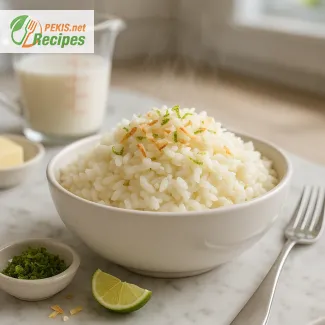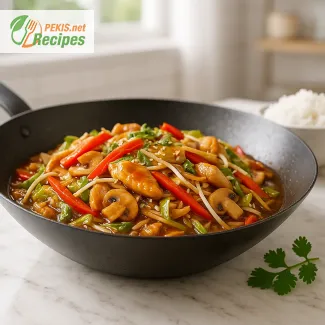
Discover the Rich Flavors of Traditional Nasi Goreng from Indonesia
A savory rice dish with bold spices, textures, and the true soul of Indonesian street food
There’s something irresistibly satisfying about a steaming plate of Nasi Goreng, the iconic Indonesian fried rice that has captivated taste buds around the world. Far from being just another rice dish, Nasi Goreng embodies the essence of Indonesia’s rich culinary heritage, balancing savory, sweet, and spicy elements with a depth of flavor that sets it apart from any other fried rice variant. Whether it’s served as a quick breakfast or a hearty dinner, this dish delivers a comforting combination of aromatic rice, umami-rich sauces, and tantalizing toppings like fried eggs, crispy shallots, and spicy sambal.
At its heart, Nasi Goreng is a dish built on simplicity and ingenuity. Originally born out of necessity to reduce food waste, it turned cold, leftover rice into a culinary masterpiece by stir-frying it with deeply flavored pastes, garlic, chilies, and the quintessential kecap manis—a thick, sweet soy sauce that adds the signature caramelized richness. In modern kitchens, it has become a versatile recipe that can easily be customized with prawns, chicken, tofu, or just vegetables, making it as adaptable as it is delicious.
What makes Nasi Goreng particularly unique is not just the flavor, but the experience it brings. The fragrance of garlic sizzling in the wok, the deep color of caramelized soy, and the slight smokiness that only a well-seasoned wok can deliver—it all adds up to a dish that stimulates the senses even before the first bite. Served with classic accompaniments like acar (pickled vegetables), kerupuk (shrimp crackers), or a side of sambal oelek, Nasi Goreng becomes a feast of flavors and textures, transporting you straight to the bustling streets of Jakarta, Bali, or Yogyakarta.
There’s a reason Nasi Goreng is considered a national treasure. It’s deeply rooted in Indonesian culture, yet it remains approachable and beloved by home cooks and chefs around the globe. Every household has its own variation, and every region adds its personal twist—be it a splash of tamarind, the use of dried anchovies, or a dollop of chili paste. Despite these differences, the soul of the dish remains the same: fragrant, full-bodied fried rice that feels like home in every spoonful.
Cooking authentic Nasi Goreng at home isn’t just about following a recipe—it’s about embracing the balance of bold flavors, the rhythm of the wok, and the use of a few humble ingredients to create something extraordinary. With just the right amount of heat, sweetness, and umami, this dish can turn an ordinary day into a celebration of culinary artistry.
In the sections that follow, we’ll walk you through the authentic method of preparing Nasi Goreng, complete with tips on ingredients, traditional techniques, and optional garnishes that elevate the dish. Whether you’re an adventurous home cook or someone looking to bring a taste of Southeast Asia into your kitchen, this recipe promises to become a new favorite in your rotation.
Let’s dive into the world of Indonesian comfort food and discover how to create an unforgettable dish that has stood the test of time.
- Prepare the rice
Ideally, use rice cooked the day before and chilled. If preparing fresh, allow it to cool fully to prevent clumping when stir-frying. - Cook the chicken
Heat 15 ml (1 tbsp) of vegetable oil in a wok over medium-high heat. Add the diced chicken and stir-fry for 4–5 minutes until golden and cooked through. Remove from wok and set aside. - Scramble the eggs
In the same wok, add a little more oil if needed. Crack the eggs directly into the wok and scramble them quickly, breaking them into small curds. Cook for 1–2 minutes and push to one side. - Sauté aromatics
Add minced garlic, shallots, and chili. Stir-fry for 1–2 minutes until fragrant, being careful not to burn them. - Combine ingredients
Return the cooked chicken to the wok. Add the cold rice and break it apart using a spatula. Mix thoroughly so the rice heats evenly and absorbs the flavors. - Add sauces and seasonings
Pour in kecap manis, soy sauce, fish sauce, salt, and pepper. Stir-fry for another 2–3 minutes until all rice grains are evenly coated and slightly caramelized. - Add fresh garnishes
Toss in chopped spring onions and give it one final stir. Remove from heat. - Assemble and serve
Plate the Nasi Goreng with cucumber and tomato slices on the side. Top with fried shallots and serve with shrimp crackers. Optionally, add a fried egg on top for a more authentic presentation.
Elevating the Classic: Creative Twists for an Even Better Nasi Goreng
Smart techniques and ingredient upgrades that take Indonesian fried rice to the next level
Nasi Goreng is already a much-loved comfort food across Southeast Asia and beyond. However, even the most authentic version leaves room for refinement, personalization, and nutritional balance. While tradition provides the foundation, culinary creativity allows us to adjust ingredients and techniques to better suit our preferences and dietary goals—without compromising flavor. From subtle flavor enhancements to texture improvements and healthier adaptations, there are many ways to elevate this beloved dish.
Use premium or homemade ingredients for deeper flavor
The flavor of Nasi Goreng depends largely on the quality of the rice, sauces, and proteins used. While store-bought kecap manis and soy sauce are convenient, making your own sweet soy sauce from molasses, palm sugar, and natural soy sauce results in a richer, less processed flavor. Similarly, homemade fried shallots bring a freshness and crunch that pre-packaged versions often lack.
When it comes to protein, replacing ordinary chicken breast with marinated chicken thighs or grilled prawns can offer a more intense and juicy texture. The same goes for the egg—opting for duck eggs instead of chicken eggs provides a silkier yolk and richer taste.
Add umami-rich enhancements for complexity
To create a more nuanced umami base, consider blending in ingredients such as:
- Shrimp paste (terasi) – A staple in Indonesian cuisine, just a small amount can dramatically boost depth.
- Dried anchovies or ikan bilis – Fried until crisp and folded into the rice for an extra layer of savory crunch.
- Shiitake mushroom powder – Adds earthy, meaty flavor, especially valuable in vegetarian versions.
Each of these adds a new layer of complexity, making the dish more satisfying and multidimensional.
Enhance texture with thoughtful additions
Texture plays a crucial role in Nasi Goreng. The contrast between soft rice and crunchy toppings makes each bite more enjoyable. To amplify this:
- Stir in crushed roasted peanuts or toasted sesame seeds for nutty undertones.
- Use crispy tofu cubes as a meat substitute with a delightful outer crust.
- Add julienned carrots or green beans, quickly stir-fried, to introduce a fresh crunch.
These additions not only improve the texture but also make the dish more visually appealing and nutrient-dense.
Healthier alternatives without sacrificing taste
While Nasi Goreng is naturally indulgent, it can be lightened with a few smart swaps:
- Replace white jasmine rice with brown rice or cauliflower rice to increase fiber and reduce glycemic load.
- Use avocado oil or cold-pressed sesame oil instead of regular vegetable oil for a better fatty acid profile.
- Opt for low-sodium soy sauce and control the amount of kecap manis to reduce sugar intake.
These small changes result in a healthier version that still retains its signature flavor and aroma.
Avoid common mistakes that can compromise the dish
Even experienced cooks can fall into habits that diminish the potential of Nasi Goreng. Here are some of the most frequent mistakes:
- Using freshly cooked rice – It tends to be too moist and clumpy. Always use rice that has been refrigerated overnight.
- Overloading the wok – This causes ingredients to steam instead of fry. Cook in small batches to ensure even caramelization.
- Adding too many sauces – The dish can become soggy and overly sweet. Stick to a balanced ratio of sweet and salty.
- Skipping the high heat – A hot wok is essential for developing the smoky, slightly charred flavor known as “wok hei”.
Correcting these missteps is crucial for achieving that restaurant-quality taste and texture.
Flavor customization for regional and personal preferences
Indonesia’s diverse culture means there are countless regional variations of Nasi Goreng. Drawing inspiration from them can help personalize the recipe:
- Nasi Goreng Jawa – Includes ground coriander and candlenut for a slightly aromatic profile.
- Nasi Goreng Kampung – Often spicier, with the addition of bird’s eye chilies and anchovies.
- Balinese style – Infused with base gede, a complex spice paste of galangal, turmeric, ginger, and lemongrass.
You can take cues from these styles or create your own version by adjusting herbs, spices, or protein sources to reflect your taste.
Why homemade always wins
Cooking Nasi Goreng at home provides not only control over ingredients but also a more personal and enjoyable experience. You can fine-tune the saltiness, heat level, and texture, and ensure freshness and quality in every component. Unlike fast food versions, a homemade dish is free from preservatives, excessive sodium, and artificial flavorings.
Moreover, preparing it yourself allows you to experiment and evolve your technique over time. As your understanding of balance, heat, and texture grows, so will the quality of your results.
Garnishes and sides that make a difference
While garnishes might seem secondary, they play a vital role in presentation and taste:
- Fried egg with a runny yolk adds creaminess and richness.
- Sliced cucumber and tomato bring cooling contrast and freshness.
- Sambal oelek or homemade chili paste lets diners adjust spice to taste.
- Pickled vegetables (acar) provide acidity that cuts through the richness.
- Kerupuk adds light, airy crunch and is deeply traditional.
These accompaniments elevate the dish into a full, balanced meal that satisfies on every level.
Improving Nasi Goreng is not about changing it entirely but about fine-tuning it to better suit your palate, lifestyle, and values. From upgrading key ingredients to mastering cooking techniques and exploring regional spins, there are endless ways to make this dish truly your own. Embrace experimentation and enjoy the process of transforming a classic Indonesian favorite into a staple in your own kitchen.
- Contains: Eggs, Soy, Fish, Gluten (soy sauce, kecap manis), Shellfish (kerupuk)
- Gluten-free alternative: Use gluten-free soy sauce and tamari in place of soy-based sauces. Omit kerupuk or use gluten-free rice crackers.
- Fish-free alternative: Replace fish sauce with mushroom soy sauce or a mix of tamari and seaweed extract.
- Egg-free version: Skip the eggs or use plant-based egg substitutes.
- Shellfish-free version: Replace kerupuk with crispy shallots or fried rice paper crisps.
- Vitamin A: 250 µg – supports vision and immune system
- Vitamin B6: 0.5 mg – essential for brain development
- Vitamin C: 9 mg – helps protect cells and aids iron absorption
- Vitamin D: 1 µg – supports bone health
- Vitamin E: 2.5 mg – protects cells from oxidative stress
- Iron: 2.1 mg – crucial for oxygen transport
- Magnesium: 45 mg – supports nerve and muscle function
- Potassium: 380 mg – helps regulate blood pressure
- Zinc: 1.8 mg – supports immune function
- Beta-carotene: 1800 µg – combats free radicals and supports eye health
- Lutein + Zeaxanthin: 350 µg – promotes eye protection from blue light
- Selenium: 14 µg – essential for DNA synthesis and antioxidant defense
Antioxidants in this dish, especially from shallots, garlic, chilies, and spring onions, contribute to reducing inflammation, supporting immunity, and protecting against oxidative cell damage.





